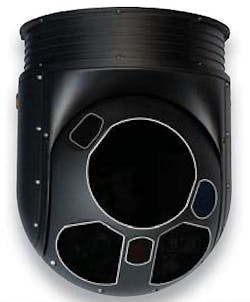Army chooses electro-optical sensors from FLIR for Persistent Ground Surveillance Systems
JOINT BASE MCGUIRE-DIX-LAKEHURST, N.J., 15 March 2012. U.S. Army officials needed high-definition electro-optical imaging sensors for the Persistent Ground Surveillance Systems (PGSS) program, which mounts a broad variety of persistent-surveillance sensors on tethered helium-filled blimps that float as high as 3,000 feet off the ground for wide-area surveillance. They found their solution from FLIR Systems Inc. in Wilsonville, Ore.
Officials of the U.S. Naval Air Warfare Center Aircraft Division-Lakehurst at Joint Base McGuire-Dix-Lakehurst, N.J., on behalf of the Army PGSS program, awarded FLIR a $10.4 million contract option Tuesday for 14 of FLIR's Star SAFIRE 380-HD digital high-definition electro-optics imaging systems for mounting on PGSS aerostats for broad-area surveillance during the day and at night.
Army leaders are using PGSS aerostats in Afghanistan and other areas to keep tabs on potential insurgents, terrorists, and other threats to U.S. military personnel and equipment.
The long-range FLIR Star SAFIRE 380-HD combines color daylight digital camera and medium-wave infrared (MWIR) thermal-imaging camera in a motion-stabilized pod that is hardened for military fixed-wing aircraft, helicopters, aerostats, and other kinds of aircraft. The Star SAFIRE 380-HD, which has an optional shortwave infrared (SWIR) camera and laser rangefinder, illuminator, and pointer, embeds metadata in its video stream.
The optional SWIR sensor in the Star SAFIRE 380-HD provides expanded multi-spectral day and night imaging with high definition mega-pixel resolution imagery. SWIR sensors can detect light from just beyond what the human eye can see to where infrared thermal imagers can perceive, and has the ability to see through windows and other kinds of glass, unlike medium- or long-wave infrared thermal imaging sensors.
SWIR light wavelengths are from 0.9 to 1.7 microns, and are reflective light, so its imagery has shadows and contrast. Since SWIR images are not in color, objects are easily to recognize. One big advantage of SWIR imaging sensors is their ability to use night sky radiance, which emits five to seven times more illumination than starlight -- nearly all of it in the SWIR wavelengths. As a result, SWIR imaging sensors use this night radiance to reveal objects clearly on moonless nights.
On this latest contract option, FLIR officials will do the work in Afghanistan and Yuma, Ariz., and should be finished by April 2013. For more information contact FLIR Systems online at www.flir.com, or the Naval Air Warfare Center Aircraft Division-Lakehurst at www.navair.navy.mil/lakehurst.
Follow Military & Aerospace Electronics news updates on Twitter
